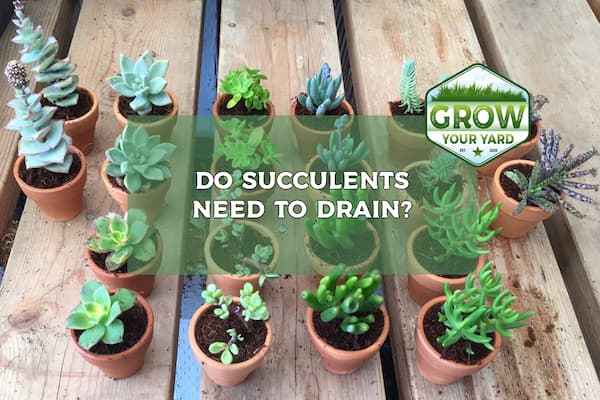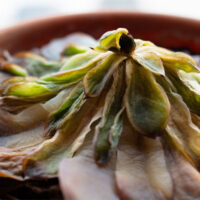In case you were wondering, do succulents need drainage? The answer is yes, and while containers with drainage holes are welcome, that doesn’t mean your succulents won’t grow in pots without drainage holes. It just means you need to be more careful about watering your succulents and monitoring soil moisture levels.
This article shares how to grow succulents in pots without drainage holes.
Table of Contents
Do Succulents Need Drainage

Can succulents survive in pots without drainage? So you decide to go ahead and grow the succulents in a container without holes. Will they survive? How long can you live? Yes, succulents can definitely survive and even thrive in pots without holes. It all depends on how you care for these plants.
The biggest problem people have is watering. People tend to overwater succulents, which can be harmful to those plants. Once you learn how to water succulents in pots without drainage, they can grow there for a long time.
This proves that succulents can survive a long time in containers without drainage. In this case, the container leaks before the plant leaks. These plants live longer than containers. How did they keep them alive for so long? Mainly from good watering technique and using the proper potting medium.
The Importance of Drainage
Whether you’re new to succulents or not, you know that the topic of drainage holes comes up a lot. Why are drain holes important? They allow excess water to seep out of the container to help prevent moisture from accumulating on the bottom of the pot.
This is significant for succulents because they contain water in their tissues, leaves, and stems. If they stay in water for too long, their roots are prone to rot. Some people insist that all pots have drainage holes.
Others are less concerned about vulnerabilities. If you have a container you really want to use for growing succulents and cacti, but you’re concerned about drainage, here are some things to consider.
How to Plant Succulents in Pots Without Holes
- Use a layer of rock
You can create a drainage layer by adding a layer of rocks, pebbles, stones, or pumice (or a combination of them) to the bottom of the jar. This helps prevent root rot as excess water drains from the soil and flows into the rocks at the bottom. This helps prevent root rot because it allows moisture to drain from the soil more quickly and prevents roots from staying in wet soil for too long.
Consider the size of the pot. If your pot is small, then you’ll mostly need pebbles and pumice, or smaller rocks. The bigger the pot, the more and more stones you need.
In addition to adding a drainage layer, you can also mix pebbles, rocks, pumice, or perlite into your cactus potting mix. Soil is usually very dense, and adding larger particles to the soil creates more space between them, allowing moisture to drain more quickly and preventing roots from lingering in wet soil for too long.
- Use activated carbon
Activated charcoal helps absorb excess moisture. It also contains natural antibacterial properties that help prevent bacterial and fungal growth. You can add a layer of activated charcoal to the bottom of the pot or rock layer, about ½ inch.
Activated charcoal is optional, but if you want extra drainage and absorption, then activated charcoal is the best option. If you are using a very small pot, you may not be able to use activated charcoal. To find out where to buy activated charcoal online, click on my resources page.
- Use the right pot size
The larger the pot, the more soil you will need. More soil means more moisture in the soil. Take a look at the plants you are using and choose the pot size accordingly.
Small plants do not need large pots. If you’re reporting, a good rule of thumb is: no more than 1-2 inches in diameter than the original pot. Succulents prefer a cozy pot, so they don’t need a lot of extra space.
How to Water Succulents Without Drainage

The key to plants surviving in pots without holes is your watering technique. Remember that excess water cannot be drained from the pot, so be careful with watering. If you’re the type of person who overwaters plants, you really need to pay extra attention to how you water plants that don’t have holes. Let the plants dry between waterings and feel the moisture in the soil.
- Use a syringe or spray bottle
Using a syringe, spray bottle, or squeeze bottle to control the amount of water you put into the container may help. When using a spray bottle, be sure to spray the soil and not the plant surface. You want the water to reach the roots and then be absorbed by the plants.
- When and How Often to Water
The timing and frequency of watering will largely depend on the climate you live in, the growing season, and the size of the container. During dry and growing seasons, plants tend to need more water. During cooler months and inactive growing seasons, plants need less water. I usually keep an eye on the plants to determine when and how often to water. In general, water about every 7-10 days during the summer months and reduce watering to 10-14 days or more during the colder months.
I keep my plants outdoors all year round and they get full sun. I also live in a very dry climate that gets very hot in the afternoon sun. If you live in a climate with high humidity, you don’t need as much water.
If you don’t know where to start, water the plants lightly and increase watering as needed. Until you figure out your plant’s watering needs, it’s best to be underwater rather than water.
- Get Rid of Excess Water
If you accidentally poured too much water, you can empty out the excess water by carefully tipping the pot over while holding down the plants so they don’t fall out. You can also use a dry towel or paper towel to dab the excess water.
- Move the Pot During Rain
If your plants are being kept outdoors, be sure to move pots without holes to a shady spot when rain is forecast. If you forget to move the kettle and it gets wet, pour out the excess water as soon as possible.
A good way to tell if plants need more water is when they start to wilt. This usually occurs first on the leaves. When you touch a plant, it feels soft but not plump, which is usually a sign that you are deficient in moisture.
Conclusion
While it’s generally recommended to grow succulents and cacti in containers with drainage holes, that doesn’t mean your plants won’t grow in pots without drainage holes.
Read More: How Big Do Succulents Get?

















